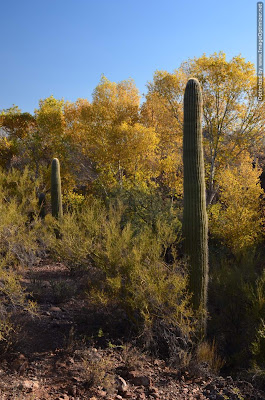 |
| A Sonoran Desert riparian area in fall along Cottonwood Creek. |
A recent hike I took demonstrated this concept extremely well. The hike was along Cottonwood Creek near Lake Pleasant north west of Phoenix. The majority of this hike is along Cottonwood Creek, which really isn't much of a creek considering water only flows in this creek a few hours every year. The rest of the year the wash remains mostly dry, except for a few locations. Nearly all washes in the desert are called dry washes, and for good reason: they are completely bone dry the majority of the year. A few washes, such as Cottonwood Creek are fortunate enough to have areas that always remain wet. Cottonwood Creek owes this moisture to its underlying geology. First off, the creek bed lays at the base of two small bajadas between two small mountain ranges. One bajada lays to the north of the creek bed and one to the south. These bajadas and bedrock of the mountains are relatively steep and provide ample runoff to Cottonwood creek so it will run during periods of heavy rainfall. Moisture is quickly lost into the deep sediments of the bajada and placed out of reach of deciduous tree roots. In areas where bedrock are shallow though, moisture cannot penetrate deeply and remains closer to the surface within reach of plant roots. Bedrock can also push water flowing underground towards the surface. At these locations large deciduous trees take advantage of the shallow moisture and can in a few places form small but beautiful wooded areas.
Wildlife may not be obvious in these small wooded areas, but if you look at the ground you are sure to see evidence of animals. Javelina and mule deer heavily utilize these small areas and their hoof prints are normally abundant. In some area, such as along Cottonwood Creek, wild donkey's are also abundant and heavily utilize these areas. The abundance of shade, food, water, and cooler conditions during hot dry summers gives great value to these areas for every creature.

No comments:
Post a Comment